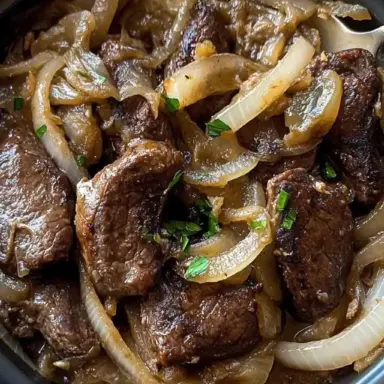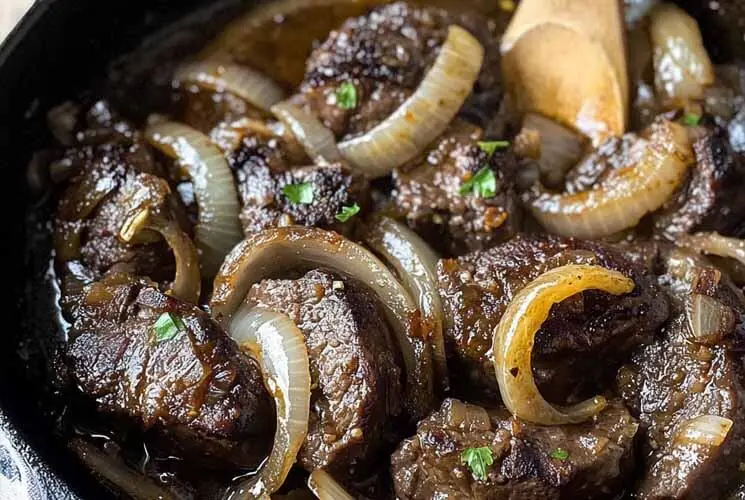Beef liver & onions is a traditional dish with deep culinary roots. Once a fixture in mid-century kitchens, it has stood the test of time thanks to its robust flavor, affordability, and nutritional value. This savory recipe pairs tender slices of beef liver with sweet, caramelized onions—resulting in a rich, comforting experience.
Historically, offal dishes like this were embraced across Europe, the Middle East, and the American South as both practical and nutritious. In many cultures, nothing from the animal was wasted, and organ meats were highly valued.
Today, the dish is enjoying a resurgence in modern cooking. Chefs and home cooks alike are rediscovering its appeal—not only for its taste but also for its dense nutritional profile and quick preparation.
Nutritional Profile of Beef Liver
If you’re looking for a superfood, look no further than beef liver. It’s packed with essential nutrients that support whole-body wellness.
Key nutrients include:
-
Iron – crucial for oxygen transport and energy levels
-
Vitamin A – promotes skin health and vision
-
Vitamin B12 – supports nerve function and red blood cell formation
-
Protein – builds and repairs tissues
-
Folate and Copper – essential for brain health and metabolism
Compared to trendy superfoods like kale or chia seeds, beef liver holds its own—and then some. According to Healthline, it’s one of the most nutrient-dense foods on the planet.
With just a few ounces, you can meet or exceed your daily requirements for many vital nutrients, making this dish not only delicious but also an efficient health booster.
Health Considerations and Risks
While beef liver offers many benefits, it’s not without cautionary notes. Because of its high concentration of vitamin A, consuming large amounts regularly can lead to hypervitaminosis A, especially in sensitive populations.
Things to consider:
-
Limit intake to once or twice a week for adults.
-
Pregnant women should be cautious due to high retinol levels.
-
Those with high cholesterol or liver conditions should consult a physician.
According to WebMD, moderation is key. When enjoyed responsibly, beef liver is a valuable addition to a balanced diet.
Selecting Quality Beef Liver
Choosing fresh, high-quality beef liver ensures a better taste and texture.
Tips for selection:
-
Look for firm, glossy slices with a deep reddish-brown color.
-
Avoid any that smell sour or appear discolored.
-
Opt for calf liver if you prefer a milder, more tender result.
-
Choose organic or grass-fed options from reputable sources when possible.
Calf liver tends to be less metallic in flavor, making it ideal for newcomers to organ meats.
Preparation Techniques
Proper prep can make or break your beef liver & onions dish. One of the best-known techniques is soaking the liver in milk or an acidic solution before cooking.
Why soak liver?
-
Neutralizes the strong, metallic taste
-
Softens texture
-
Improves overall palatability
Other prep tips:
-
Slice the liver into even ¼-inch pieces for uniform cooking.
-
Remove membranes and connective tissue for a smoother bite.
-
Season with salt, pepper, garlic powder, or your favorite herbs.
-
Optional: Marinate in buttermilk or lemon juice for an extra flavor boost.
Taking these steps ensures your liver is tender and flavorful without the bitter edge.
Cooking Methods
There’s more than one way to cook beef liver & onions, but pan-frying remains the gold standard.
Classic pan-frying method:
-
Heat butter or oil in a heavy skillet.
-
Lightly dredge liver slices in flour, salt, and pepper.
-
Sear on medium-high heat for 2–3 minutes per side.
-
Remove liver and sauté thinly sliced onions until golden and soft.
-
Return liver to the pan, combine with onions, and simmer for 1–2 minutes.
Other methods to try:
-
Baking: Place liver and onions in a casserole with broth; bake at 350°F for 20–25 minutes.
Advertisement -
Grilling: Marinate liver and grill quickly over high heat for a smoky flavor.
-
Slow cooking: Combine ingredients in a slow cooker with broth and cook on low for 4–6 hours.
Pro tip: Don’t overcook! Liver becomes tough and grainy when left too long on the heat. Aim for a slightly pink center for maximum tenderness.
Serving Suggestions
The beauty of beef liver & onions lies in its versatility. Whether you prefer old-school sides or modern plating, this dish delivers.
Classic pairings include:
-
Mashed potatoes with butter and cream
-
Steamed green beans, peas, or carrots
-
White or brown rice with herbs
Modern serving ideas:
-
Layered in a hearty sandwich with mustard and pickles
-
Served over greens or grain bowls for a liver-based salad
-
Tucked into soft tacos with grilled onions and a drizzle of aioli
Beverage pairings:
-
A glass of dry red wine (like Cabernet or Syrah)
-
Dark beer or stout for richer tones
-
Herbal iced tea or sparkling water with lemon for a lighter touch
With the right sides and drink, this humble dish transforms into a gourmet experience.
Recipe Variations
Give your liver recipe a twist by adding new flavors or adapting it to suit dietary needs.
Tasty additions:
-
Crispy bacon bits for smoky richness
-
Sautéed mushrooms for earthiness
-
Fresh thyme, parsley, or rosemary for aroma
Regional and international twists:
-
Southern-style: Use cornmeal breading and add hot sauce
-
French-style: Deglaze the pan with red wine and finish with butter
-
Middle Eastern: Add cumin and serve with couscous
Dietary adjustments:
-
Make it gluten-free by skipping the flour coating
-
Use coconut oil and veggie sides for a low-carb/keto version
-
Swap in plant-based butter for a dairy-free take
These variations ensure everyone can enjoy beef liver & onions—no matter their taste or lifestyle.
Storage and Reheating Tips
Proper storage ensures your beef liver & onions leftovers stay safe and tasty.
Best practices:
-
Refrigerate in an airtight container for up to 3 days
-
Do not leave cooked liver at room temperature longer than 2 hours
Reheating tips:
-
Use a skillet on low heat with a splash of water or broth
-
Avoid the microwave if possible—it can make the liver rubbery
Safety note:
-
Discard if you notice an off smell, sliminess, or dull color
-
Always reheat to 165°F (74°C) internal temperature
These steps help retain the flavor while ensuring food safety.
Frequently Asked Questions (FAQs)
Why soak liver in milk before cooking?
To neutralize bitterness and tenderize the liver, improving flavor and texture.
How do you know when liver is fully cooked?
It should be lightly pink inside, not raw or bloody. Overcooked liver turns gray and becomes tough.
Can you freeze cooked liver and onions?
Yes, but it may lose texture. Freeze in airtight containers and reheat gently.
What are the signs of spoiled beef liver?
Ammonia-like odor, green or gray spots, or slimy texture indicate spoilage. Don’t take chances—discard if unsure.

Beef Liver & Onions Recipe
Equipment
- Sharp knife
- Large skillet or frying pan
- Mixing bowl (for soaking)
- Tongs or spatula
- Plate with paper towels
Ingredients
- 1 pound beef liver sliced ¼-inch thick
- 1 cup whole milk for soaking
- 1 cup all-purpose flour optional, for dredging
- 2 large yellow onions thinly sliced
- 4 tablespoons butter or oil
- ½ teaspoon salt
- ½ teaspoon black pepper
- Optional: 1 teaspoon garlic powder 1 tablespoon chopped parsley
Instructions
- Soak the Liver: Place the sliced beef liver in a bowl and cover with milk. Let soak for 30–60 minutes to reduce bitterness.
- Prep Onions: While the liver soaks, slice the onions thinly.
- Caramelize Onions: Heat 2 tablespoons of butter or oil in a skillet over medium heat. Add onions and cook for 10–12 minutes, stirring occasionally, until golden brown and soft. Remove and set aside.
- Prepare Liver: Drain and pat liver dry with paper towels. Lightly dredge each piece in flour mixed with salt, pepper, and optional garlic powder.
- Cook the Liver: In the same skillet, heat remaining butter/oil over medium-high heat. Cook liver slices for about 2–3 minutes per side. Do not overcook—liver should be slightly pink inside.
- Combine and Serve: Return onions to the skillet, toss gently with the liver, and heat for another minute. Garnish with parsley if desired and serve immediately.
Notes
- Soaking in milk helps mellow the strong taste of liver—don't skip it if you're sensitive to flavor.
- For a low-carb version, skip the flour and use almond flour or cook liver directly without dredging.
- Want a Southern twist? Add a splash of hot sauce or bacon to the onions while they cook.
- Store leftovers in an airtight container for up to 3 days. Reheat gently in a skillet to avoid tough texture.
Nutrition

